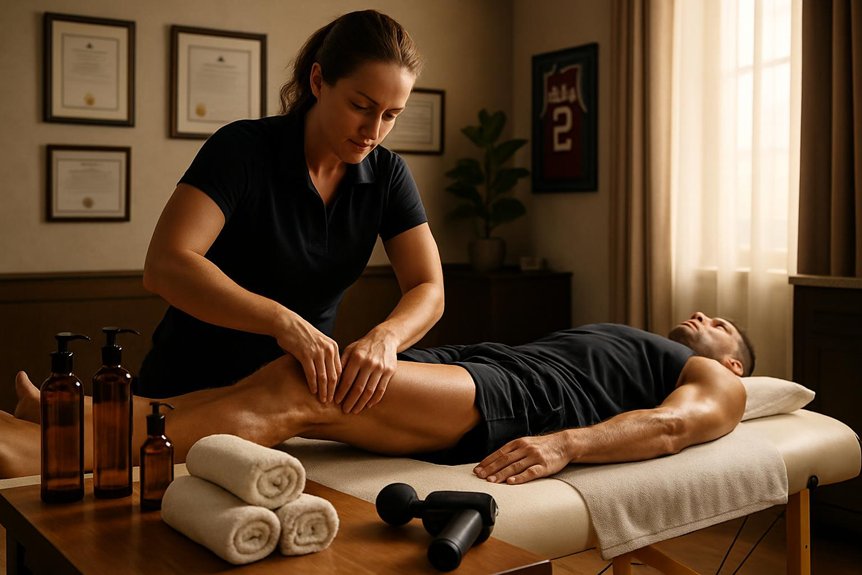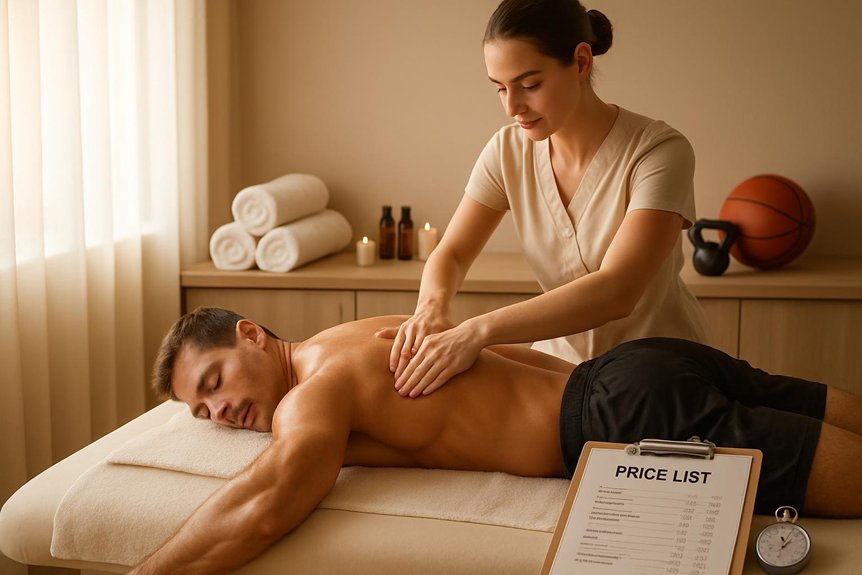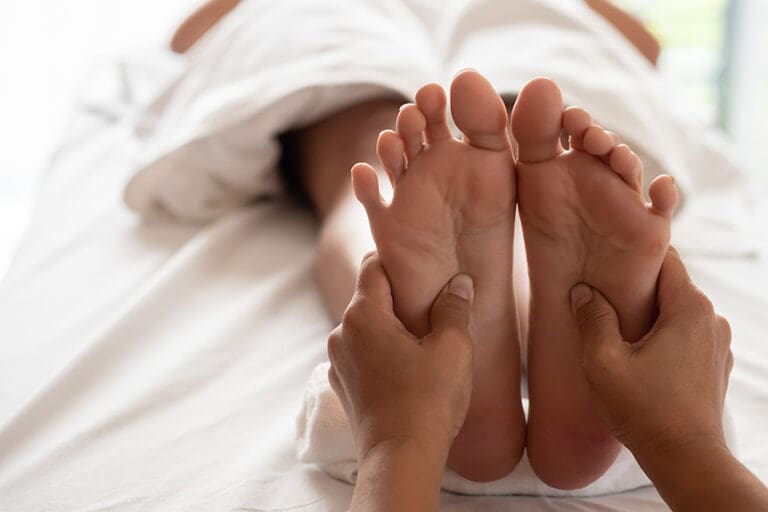In London, athletic massage typically costs £45–£95 per session. Prices vary by session length (30–90 minutes), therapist expertise, location, appointment timing, and treatment complexity. Short sessions target one area but have higher per‑minute rates; 45–60 minutes balance assessment and treatment; longer sessions cover multiple regions. Central postcodes and peak hours cost more. Add‑ons like cupping or assisted stretching may increase fees. Packages and memberships can cut costs by 10–15%. Further details explain how to match options to goals.
What Influences the Price of a Athletic Massage

Although rates vary by clinic and client needs, the cost of a athletic massage is primarily influenced by session length, therapist expertise, location, appointment timing, and treatment complexity.
Longer appointments allow thorough assessment, warm-up, focused manual work, and reassessment, increasing price.
Senior therapists command higher fees due to advanced training in soft-tissue assessment, neuromuscular techniques, and injury management.
London location affects overheads; central and high-demand areas typically carry higher operating costs.
Timing also matters. Peak-hour bookings and short-notice appointments often price higher than off-peak slots.
Treatment complexity—multiple problem areas, post-injury care, or sport-specific pre-event work—requires specialised techniques and clinical reasoning, which adds cost.
At Spa & Massage, transparent pricing reflects these variables, with personalised plans that respect goals, comfort, and recovery timelines.
Many clients also explore complementary options such as reflexology to support their overall healing and recovery process alongside athletic massage.
Typical Sports Massage Price Ranges in London
Across London, athletic massage prices generally fall into clear bands tied to session length and therapist seniority. Entry-level therapists commonly charge around £45–£60 for shorter appointments, while experienced practitioners and clinic leads tend to range between £65–£95, reflecting advanced assessment and targeted techniques.
Central postcodes and weekend bookings can sit at the higher end.
From Spa & Massage’s perspective, transparent pricing helps clients plan care without surprises. Across our London clinics in Crouch End, Bayswater, Chiswick, Earl’s Court, Belsize Park, and Richmond, typical fees reflect clinical time, therapist expertise, and the hands-on focus required for performance and recovery.
Packages and multi-session bundles often lower the per-session rate, supporting consistent progress. Clients value knowing that evidence-based pressure, focused mobilisations, and clear goals are built into every appointment.
Session Lengths and How They Affect Cost
Because session length determines how much assessment and hands-on time a therapist can provide, it also drives price. Shorter sessions (30 minutes) typically focus on one area and cost less per visit but more per minute. Standard 45–60 minute appointments allow brief assessment, warm-up, focused technique, and reassessment—often the best value for most training schedules.
Extended 75–90 minute sessions support multi-region work, slower pacing, and recovery-focused techniques, with a higher total fee but lower marginal cost per minute.
From Spa & Massage’s clinical perspective, session choice should match goals and training load. Acute issues may warrant several shorter visits; complex patterns benefit from longer appointments. Their therapists discuss priorities, then recommend the minimum time needed to achieve measurable change—an approach that protects both outcomes and budget.
Clinic Locations and Their Impact on Pricing
Location influences price through central vs. suburban rates, as clinics in high-footfall areas typically face higher rents and operating costs.
Overhead variations—such as property prices, business rates, and staffing expenses—are reflected in session fees.
Therapist availability by area can also shift pricing, with peak-demand zones commanding premium rates due to limited appointment capacity.
Central vs. Suburban Rates
In London, clinic location influences athletic massage pricing through rent, staffing, and demand patterns. Central neighborhoods typically command higher session fees due to denser appointment requests at peak times and extended operating hours for commuters.
Suburban areas often offer slightly lower rates, reflecting steadier, local demand and more flexible scheduling. Price tiers also vary by therapist seniority and session length, with central clinics seeing greater uptake of premium, longer appointments.
From Spa & Massage’s perspective, transparent pricing helps clients plan with confidence across its London locations—Crouch End, Bayswater, Chiswick, Earl’s Court, Belsize Park, and Richmond.
Clients prioritizing convenience near work may choose central appointments; those seeking quieter times may prefer suburban slots. Either way, consistent clinical standards, tailored techniques, and clear treatment goals guarantee value beyond postcode.
Rent and Overhead Differences
While session length and therapist expertise shape value, fixed costs such as rent, business rates, utilities, and staffing are primary drivers of athletic massage pricing across London.
Areas with higher commercial rents and rates require higher session fees to maintain safe premises, regulated equipment, and adequate appointment capacity. Energy-intensive services—heated rooms, laundry, and hygiene protocols—also scale costs.
From Spa & Massage’s perspective, each clinic balances local overheads with consistent clinical standards. Sites in denser zones often face higher rents, security, and maintenance spend; suburban locations may benefit from lower fixed costs and pass efficiencies on to clients.
Regardless of postcode, pricing reflects the same investment in accredited therapists, reception support, compliant facilities, and reliable availability—so clients receive attentive, outcome-focused care in a calm, well-run setting.
Therapist Availability by Area
Beyond overheads, therapist availability across London also shapes athletic massage fees. Where skilled practitioners are scarce, prices trend higher to balance demand with limited appointment slots. Where supply is deeper, rates stabilize and last‑minute bookings become easier.
Spa & Massage clinics in Crouch End, Bayswater, Chiswick, Earl’s Court, Belsize Park, and Richmond see distinct booking patterns tied to commuting flows, local sport participation, and evening/weekend demand.
Peak times—pre‑work, lunchtime, and after 6 p.m.—command premium pricing in busier postcodes. Conversely, off‑peak rates can offer value without compromising quality.
Consistent with Spa & Massage’s approach, flexible staffing and cross‑site scheduling help maintain access and transparent pricing. Clients seeking budget certainty often book series packages or off‑peak sessions.
Meanwhile, those prioritising continuity tend to reserve preferred therapists in advance.
Add‑Ons and Upgrades: What You Might Pay Extra For
A clear pricing picture for athletic massage should include potential add‑ons and upgrades that enhance outcomes but may increase the final cost. Common extras include extended session time for complex cases, targeted assessment, and post‑treatment taping.
At Spa & Massage clinics across London, clients may also request focused instrument‑assisted work, localized heat therapy, or gentle cupping to modulate fascia and circulation. Premium oils or hypoallergenic options can be selected when skin sensitivity matters.
Some choose pre‑event activation or post‑event recovery protocols, which add structured warm‑up or cooldown work. Aftercare support—such as individualized mobility drills or emailed plans—can be included for a modest fee.
Their therapists discuss suitability first, prioritizing safety, evidence‑led rationale, and tangible benefits before recommending any upgrade.
Ways to Save: Packages, Memberships, and Bundles
For budget‑minded clients, structured savings come from booking strategically through packages, memberships, and event bundles. At Spa & Massage, advance-purchase packages typically reduce the per‑session rate by 10–15% while encouraging consistent care—crucial for performance and recovery.
Memberships provide deeper value for regulars: predictable monthly fees, lower member rates on extra sessions, and priority booking across our London clinics. Clients training for races or team events often prefer bundles timed to their calendar—e.g., a pre‑event flush, mid‑block maintenance, and post‑event recovery—priced below standalone bookings.
Savings extend beyond price. Continuity with the same therapist refines treatment plans, shortens reassessment time, and can reduce overall session frequency.
Flexible redemption across Crouch End, Bayswater, Chiswick, Earl’s Court, Belsize Park, and Richmond supports busy schedules without sacrificing touchpoints.
Is Performance Massage Worth the Cost for Your Goals
Securing savings through packages and memberships is meaningful only if sessions deliver measurable outcomes.
For athletes and active clients, athletic massage is worth the cost when it improves performance markers, reduces recovery time, and lowers injury incidence. Evidence supports targeted soft-tissue work for range of motion, delayed onset muscle soreness, and perceived exertion.
At Spa & Massage, therapists assess baseline mobility, pain scores, and training load, then tailor pressure, tempo, and techniques. Worth is demonstrated when clients sleep better, return to training sooner, and sustain consistent form.
Frequency matters: event prep may require weekly sessions; maintenance often succeeds at 2–4 weeks.
Cost becomes value when objectives are specific—faster 10K, pain-free lifting, or postnatal return to running—and progress is tracked session to session.
How to Choose the Right Session for Your Budget and Needs
Choosing the right athletic massage starts with matching session length to the goal: shorter sessions target one or two problem areas, while longer appointments allow full-body assessment and corrective work.
At Spa & Massage, therapists guide clients toward the most cost-effective duration based on symptom severity, training load, and recovery timelines.
Value-driven add-ons—such as focused stretching, assisted range-of-motion work, or heat/cooling applications—are recommended only when they enhance outcomes relative to cost.
Session Length Options
While budgets and goals vary, session length is the main lever that aligns outcomes with cost in athletic massage. Short sessions (30 minutes) suit a single hotspot—calf, shoulder, or lower back—when the aim is targeted relief and minimal downtime.
A standard session (45–60 minutes) allows assessment, focused work on one or two regions, and time to reduce post-treatment soreness.
Longer formats (75–90 minutes) support complex needs: multiple areas, mobility work, and paced pressure to access deeper layers safely.
At Spa & Massage clinics across London, therapists guide clients toward the smallest session that still matches objectives. Acute issues often start with 45 minutes; chronic patterns or training phases benefit from 60–90 minutes.
Frequency matters: shorter, regular sessions can rival occasional long appointments for outcomes and value.
Value-Driven Add-Ons
A targeted add-on can improve outcomes without inflating costs when it directly supports the client’s goal. At Spa & Massage, therapists recommend only evidence-backed enhancements that complement athletic massage and fit the budget.
For acute soreness or post-event fatigue, localized percussion or assisted stretching often delivers the highest return, shortening recovery windows.
For persistent tightness, focused cupping or instrument-assisted soft tissue work can free adhesions efficiently, avoiding longer sessions.
Heat therapy primes rigid tissue; cold application moderates inflammation after intensive work.
Aromatherapy is optional; in our clinics, neutral, skin-friendly oils remain standard, with calming or uplifting blends used selectively to support relaxation before deep work.
Clients are advised to choose one add-on per session, review response, and adjust—paying for results, not extras.
Conclusion
In closing, the reader is reminded that athletic massage pricing reflects measurable variables: session length, therapist expertise, clinic location, and treatment objectives. Transparent fees typically include consultation, assessment, targeted techniques, and aftercare advice, with add‑ons clearly itemized. Evidence suggests strategic packages benefit ongoing training and rehabilitation. Like calibrating a GPS in a horse‑drawn carriage, informed choices reconcile modern precision with timeless needs: invest where outcomes align with goals, select appropriate durations, and leverage memberships to maximise value and clinical effectiveness.



